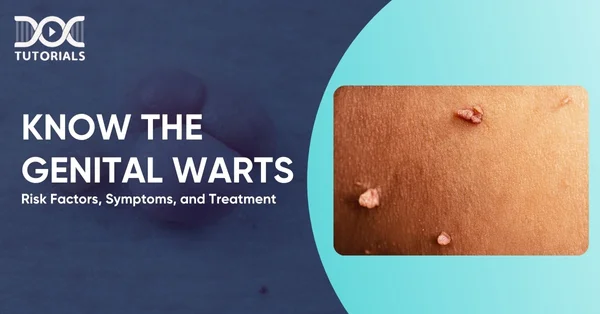Know the Genital Warts Symptoms, Causes, Diagnosis, and More

Genital warts are one of the most common sexually transmitted infections (STIs). The human papillomavirus (HPV) is the main cause. A lot of people come into contact with HPV, but only around 10% of those who do get genital warts. Types 6 and 11 are the most prevalent ones that cause this. About 90% of people who are exposed to HPV never display symptoms or pass the virus on, which is interesting.
For people who want to take the NEET PG exam, it’s important to know the symptoms, causes, ways to diagnose, and treatment choices for genital warts, both for clinical reasons and for studying for the test.
What are Genital Warts?
Genital warts are small growths that can be flesh-colored or gray and grow in the genital area, like the penis, scrotum, cervix, vulva, vagina, and around the anus. These growths can be flat or raised, happen one at a time or in groups, and sometimes look like a cauliflower.
Most of the time, they are linked to certain strains of the human papillomavirus (HPV), especially kinds 6 and 11, which are considered to be low-risk for cancer. Genital warts are not life-threatening, but they can have a big impact on a person’s mental health and quality of life as a whole.
What Do Genital Warts Look Like?
Here are some of the signs of genital warts that you could see:
- The presence of small, grayish or flesh-colored bumps in the vaginal area
- Itching or a feeling of pain in the area that is impacted
- Bleeding while having sex
- Changes in the size, shape, or texture of the warts over time that happen slowly
What are the Causes of Genital Warts?
Certain strains of the HPV are mostly to blame for the symptoms of genital warts. The virus spreads when two people touch each other’s skin directly during sex. It’s important to know that the HPV strains that cause genital warts are not the same as the ones that cause warts on the hands or feet. Because of this, genital warts cannot be spread by touching warts on other regions of the body.
Genital warts can be spread through different types of sexual contact, such as:
- Intercourse in the vagina, anus, or between people of the same sex
- Touching genitals without penetration or ejaculation
- If you have oral intercourse with someone who has visible genital warts, you could get the virus.
- Also, getting oral sex from someone who has warts on their lips, mouth, or tongue might also put you at risk of getting an infection.
It’s hard to find and stop the virus because it can be spread even when warts aren’t visible. To do this, you need the right protection and regular health checkups.
What are the Risk Factors of Genital Warts?
There are a number of things that can make it more likely for both men and women to get genital warts:
- Location
The number of HPV cases can be different in different places because of cultural norms, sexual behaviour patterns, and how easy it is to get health treatment. - Gender
Women are more likely than men to have noticeable genital warts. This could be because of variations in anatomy and the fact that women are more likely to get HPV infections. - Age
Young adults, especially those between the ages of 15 and 24, are much more likely to do this. This is mostly because they have sex more often during this time. - Health Problems That Are Already There
People who have a weak immune system or have had sexually transmitted illnesses in the past are more likely to get genital warts.
How Do You Tell If You Have Genital Warts?
A clinical assessment based on the appearance of the warts is usually the first step in diagnosing genital warts. A biopsy may be done in some cases to confirm the diagnosis. A gynaecologist may conduct additional tests to obtain a clearer picture, especially if the warts aren’t easily visible. These tests are done to look at regions like the cervix.
People often utilise the following methods:
- Examining the Pelvis
This includes a thorough examination of all the pelvic organs, both internally and externally, as well as the vulva, labia, vaginal walls, and cervix. A laparoscopy or colposcopy can help with a visual assessment and find any problems with the vaginal tissues and external genital parts. - Pap Test with ThinPrep
If a woman has HPV signs including unusual vaginal bleeding, discharge, or pus, a ThinPrep Pap test may be suggested. This test helps find cervical cancer, which can be linked to high-risk strains of HPV. - Test for HPV DNA
This is a full diagnostic tool that can find some types of HPV that cause genital warts and those that are more likely to cause cervical cancer. - Rectal Checkup
If you think you could have genital warts around your anus, a rectal exam with an anoscope can be done to look for problems with the anal sphincter or the outside of the anus.
For genital warts therapy to work, it is important to get the right diagnosis. If you have genital warts and they are bleeding, discharging, or are in people who are more likely to get sexually transmitted illnesses, you should see a doctor very often.
What Problems Might Genital Warts Cause?
If you get the human papillomavirus (HPV), it can occasionally cause a lot of problems, especially if you don’t get treatment or if you get a high-risk strain. They are:
- Cancer
There is a strong relationship between HPV and cervical cancer. Also, some strains of HPV are linked to malignancies of the vulva, penis, anus, mouth, and throat. Not all HPV infections cause cancer, but people who are more likely to have problems with HPV should have frequent cervical screenings, like Pap tests. - Problems Related to Pregnancy
In very rare circumstances, genital warts can get bigger during pregnancy, which could make it harder to urinate. Warts on the vaginal wall may make it harder for the birth canal to open up normally during labor. Also, big warts on the vulva or in the vaginal channel might rip and bleed when they are stretched during birth. - Problems with Newborns
Respiratory papillomatosis is a disorder that can impede breathing and may require genital warts medication. It is rare, however, babies delivered to moms with genital warts may develop growths in their throats.
What to Do About Genital Warts
There is currently no complete cure for genital warts. But there are a number of topical therapies that can help with genital warts, especially those that impact the vaginal and anal areas:
- Imiquimod (Zyclara, Aldara)
Is a cream that helps the body fight the infection by boosting the immune system. You should not have sex while the cream is still on your skin since it can irritate your partner and make condoms and diaphragms less effective. Some side effects are skin redness, blisters, rashes, bodily aches, coughing, and tiredness. - Podophyllin and Podofilox (Condylox)
A healthcare provider uses podophyllin, derived from plants, to treat wart tissue. People can also use Podofilox at home because it has a similar active component. This treatment should not be given through an IV and should not be given to pregnant women. Pain, blisters, and moderate skin irritation are some of the possible adverse effects. - Trichloroacetic Acid (TCA)
This chemical burns off genital warts and is also effective on interior lesions. Some people may feel discomfort, get blisters, or get irritated after using it. - Cinnamomum Extract (Sicnecatechíns)
This ointment is typically used for warts on the external genitalia and around the anus. It can cause minor side effects, including irritation, burning, itching, and redness.
If warts are really big, don’t respond to topical treatments, or could spread to a newborn during childbirth, surgery may be needed.
- Cryotherapy VI (Freezing with Liquid Implications)
This treatment destroys the wart by estim Highland called a blister. As the healing process goes on, the wart falls out, letting new skin grow. Swelling and pain are common adverse effects. - Electrosurgery
This procedure uses electricity to burn off the warts. It’s normal to have discomfort and oedema after surgery. - Surgical Removal
You can get rid of warts with minimal surgery while you’re awake or asleep. After the genital warts surgical procedure, you may feel some pain. - Treatment with Lasers
This method uses a focused beam of light to remove warts that are difficult to treat or that are widespread. Because it costs a lot, it is usually only used for harder instances. You may get scars and feel pain.
How to Keep Genital Warts from Happening
The first step in lowering the risk of genital warts is to avoid getting HPV. There are a number of practical steps that can be taken to lower the risk of transmission:
- Getting Vaccinated
Getting the HPV vaccine protects you from the most common types of the virus, including the ones that cause genital warts. It is best to talk to a doctor or nurse to find out the best immunisation regimen for you. - Limiting the Number of Sexual Partners
If you have intercourse with more than one person, you are more likely to get HPV and other sexually transmitted diseases. If you and your partner are both monogamous or if you have fewer sexual partners, you may be less likely to have genital warts. - Safe Sex Practices
Using condoms correctly and every time you have sex will dramatically lower your chances of passing on HPV. But it’s crucial to remember that condoms don’t offer full protection because the virus might still reside on skin that isn’t covered. - Regular Health Checks
Regular cervical screenings, including Pap tests, are very important for finding early indicators of HPV-related alterations, even in people who may not have obvious genital warts.
FAQs About Genital Warts
- What is the appearance of genital warts?
Genital warts are usually seen as small bumps that are either flesh-toned or grey in colour. They may be flat or elevated and often develop in clusters, resembling a cauliflower-like texture, within the genital region.
- How can the transmission of genital warts be prevented?
The spread of genital warts can be minimised through consistent use of protection during sexual activity, receiving the HPV vaccine, and avoiding direct contact with any visible warts.
- Is there a connection between genital warts and the development of cancer?
The HPV strains responsible for genital warts are generally considered low risk for causing cancer. Nonetheless, some high-risk HPV strains are associated with cervical cancer as well as other genital and oropharyngeal cancers. Regular health screenings are vital for the early identification and management of these conditions.
Conclusion
Genital warts, though common, are a controllable condition resulting from HPV infection. A thorough understanding of genital warts symptoms, causes, and available treatments is crucial for maintaining sexual health. For NEET PG aspirants, having a solid grasp of such topics not only aids clinical awareness but also strengthens exam readiness.
To get a clear understanding of such topics, start learning with DocTutorials – your trusted exam partner. We offer an extensive collection of topics, including medicine, dermatology, anatomy, and more, with concise video lectures, high-yield notes, and mock tests to take your exam preparation to the next level. Check out our NEET PG study materials now!
Latest Blogs
-

NEET SS Exam 2024: Analysis, Key Dates, Counselling
The NEET SS 2024 exam kicked off on March 29, 2025. Over two days and two slots, candidates across 13…
-

NEET PG Registration 2025: An Essential Guide For Exam Prep
The NEET PG registration, which is conducted online, is a crucial step in the exam process. Filling out the NEET…
-

NEET PG Syllabus 2026: A Must-Have Complete Guide for Exam Success
The NEET PG Syllabus acts as one of the foundation stones for aspiring postgraduate medical students like you who are…




